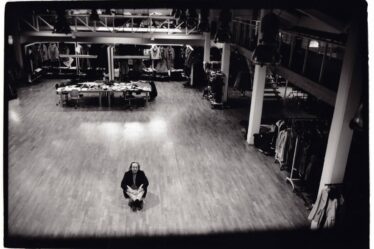
Flan: not the cheese-and-tomato traybake served up for British school dinners or the Latin American creme caramel, but the magnificent custard tart that stands proud on so many French bakery counters.
I have become mildly obsessed with flans, for their unapologetic plainness, for the sturdiness of the starch-thickened filling (which is so different from the more delicate, nutmeg-flecked British custard tart) and, mostly, for the fact that they sanction the consumption of what is, essentially, a wedge of solid custard.
Flan is sometimes sold as flan pâtissier, sometimes as flan parisien and occasionally as a far breton (though, as far as I can tell, the latter tends to contain fruit). Pastry chef and Paris resident David Lebovitz explains that there “are a lot of variations on the name and the way it’s baked, so I just go into a bakery and order it by whatever name they decide to give it. (Rule #1: avoid arguing with people serving you food.)”
Rule #2: flan may not be the flashiest pastry on offer at most patisseries, but it will be the one you wake up in the middle of the night two weeks later desperate to recreate. Here’s how.
The pastry
Rolling-pin phobes and coeliacs will be delighted to learn that one can dispense with the pastry altogether, and with it the pretence that a flan is about anything other than custard – though, as Lebovitz observes, “the crust certainly makes the dessert more dramatic”. Master patissier Christophe Michalak apparently believes a crustless flan is lighter and more digestible; I’m no nutritionist, but I can confirm it’s an awful lot quicker and easier to prepare.
That said, eliminating the pastry means no pleasurable contrast between crisp crust and soft filling, so though you can, by all means, bake the custard in a well-buttered baking dish, it won’t be quite the same. If you don’t do gluten but do like pastry, note that pastry chef Brian Levy links to his gluten-free version in his piece for Nicola Lamb’s Kitchen Projects Substack.
You could, of course, save time by buying your pastry readymade, though I wouldn’t recommend using puff; I try that in the Atelier des Chefs flan, and my testers and I find the flakiness a less enjoyable textural pairing than snappier, shorter crusts, particularly given the importance of leaving the custard to cool completely before serving, which gives those airy layers ample time to sink and soften.

I test a couple of rich, sweet recipes, too, one, from baker and author Richard Bertinet’s book Pastry, with half as much butter and sugar as flour, and two eggs plus an extra yolk, which is delicious but very delicate. The other is a slightly less buttery version using icing sugar and ground almonds from Nicola Lamb, which is easier to work with and has a gorgeous flavour. The most popular, however, is Edd Kimber’s savoury shortcrust, from his Boy Who Bakes substack, that’s hydrated with water rather than egg, which makes it incredibly crunchy – and anyway, one might conclude there’s enough egg in the filling not to miss it in the crust.
Though many more adept than I believe that there’s little point in blind baking pastry before pouring in such a wet filling, I agree with Kimber that skipping this step results in “underbaked, pale pastry … the [base] doesn’t get the chance to brown properly and … will inevitably take on a little moisture from the custard, this results in an insipid pastry that is a bit pasty. Now, many bakeries bake their flan using this method, and I know there are people that actually like their pastry like this, but for me I want the pastry well baked, golden and with some crispness.” Me, too, Edd, me, too. In fact, I’m going to brush the pastry with the egg whites left over from the custard as extra insurance against sogginess.
I also like Kimber’s tin-lining technique, which is new to me, but which also pops up in Lamb’s new book Sift. This involves separately lining the sides and base of the pan, which, though it sounds fiddly, is actually far more practical when you’re working with a deep tin.
The custard
Let’s be honest, this is all that most people care about here. Note that flan is not made with a purely egg-thickened custard, but a creme patissier thickened by both eggs and starch, which puts it somewhere between creme anglaise and my beloved Bird’s. This means that the delicate, silky wobble of a creme caramel is not the aim here; a flan must be robust enough to be self-supporting, even when sliced, and a certain flexibility – or rubberiness, if I’m being completely honest – is also desirable, so embrace it.
That custard can be made with milk alone (whole milk, please), as in the Atelier des Chefs recipe, or with a proportion of cream as well. Many French recipes call for crème liquide, which has a fat content more consistent with our own whipping cream or American heavy cream than with the double cream used by Kimber (30-35% as opposed to 48%). The more fat you add to the creme pat, be it in the form of dairy or egg yolk, the softer and richer the custard will be, while the more egg white you include, the firmer and more jelly-like its texture and the milder the flavour.
As I want this to have more body than a set custard, I’m going to use an equal number of whole eggs to yolks, as Kimber and Bertinet suggest, rather than yolks alone (Michalak); the Atelier des Chefs flan, made with only whole eggs, is a little too light for my liking. I’ve tended towards Levy’s modest ratio of milk to cream, however, rather than the equal parts suggested by Bertinet – though I’m never one to be swayed by aesthetics over taste, the visual appeal of a substantial wedge of flan cannot be underplayed, which means it shouldn’t be so heavy as to require wafer-thin portions. No one wants a slender slice of flan.
For the same reason, I won’t be enriching the custard with Kimber’s knob of butter, but feel free to disagree. And note that I’ve used double cream, because it’s easier for me to get good-quality stuff than it is with whipping cream; you could always substitute the latter and adjust the proportions slightly.
Cornflour is the patissier’s thickener of choice, which is handy, because it also happens to be gluten-free, though Atelier des Chefs uses equal parts wheat and corn flour. Wheat flour is supposed to make the custard more stable, but I don’t find separation a problem with any of the recipes I try – plus, the less flour, the silkier the consistency. Make sure you let the custard simmer for at least 30 seconds before taking it off the heat, stirring all the time, or it won’t set properly – the starch gelatinises and thickens the mixture at about 79C, but amylase, an enzyme in the egg yolks, will break it down again if it’s not deactivated by bringing the custard to just below a full boil and holding it there. Don’t worry, the starch also means the custard mix is unlikely to scramble, but do keep stirring to prevent it burning.
Vanilla is the classic choice of flavouring here, with most recipes infusing the dairy before use (Levy calls for up to three pods, which makes his flan so luxuriantly speckled with seeds that they crunch in the mouth, but you could always use less expensive vanilla extract if you prefer). Michalak doesn’t add any extra flavourings, and indeed there’s no need given how nice sugared cream is on its own. Or experiment with alternatives: Kristina Razon mentions lemon and chocolate versions in her piece for Serious Eats, for example.
The tin and the bake time
As previously mentioned, this is essentially a custard rather than a pastry dish, which dictates a fairly deep mould. But it’s also a dish with a liquid filling, which means that, even if you blind bake the pastry, I would caution against using a loose-bottomed tin. Even though Kimber’s version in a springform pan (which I wrap in foil and place in a shallow bowl, just in case) works out fine, I’m loth to recommend taking the risk, especially with such expensive ingredients. Given that solid pie tins are available only in slightly larger sizes (I find them from 20cm up, and buy one described as a tarte tatin dish), I suggest making a large flan; it will keep well for a few days and in my experience is easy to give away if you can’t manage the whole thing.
I’m blind baking the pastry, so I’ve kept the baking temperature fairly low to guard against scorching its edges. This adds to the time in the oven, but the results are worth it. If you’d like your flan to have the gorgeously browned top boasted by Levy’s version, feel free to turn the temperature up right at the end to help things along, but I think it looks pretty irresistible as is.
Perfect flan
Prep 15 min
Infuse 1 hr
Chill 1 hr 30 min+
Cook 1 hr 20 min
For the pastry (or use 300g ready-made all-butter shortcrust; optional)
200g plain flour, plus extra for dusting
1 tbsp icing sugar
¼-½ tsp fine salt
105g cold butter, diced
For the custard filling
750ml whole milk
150ml double cream
1-2 vanilla pods, depending on taste and budget
4 eggs plus 2 egg yolks
80g cornflour
150g caster sugar
If you’re making your own pastry, start with that. Whisk the dry ingredients in a large bowl, then rub in the butter, or whizz it in a food processor – stop as soon as you can see no large pieces of butter.
Stir in just enough water (you’ll need about two tablespoons) to bring the mix together into a smooth dough, then divide in half, and shape one half into a flat disc and the other into a flat rectangle.
Wrap each piece of pastry individually, then chill for at least 30 minutes.
Meanwhile, put the milk and cream in a medium saucepan. Slit open the vanilla pod(s) lengthways, then scrape out the seeds.
Put the seeds and pod(s) in the milk pan and bring slowly to just below a simmer, stirring occasionally. Take off the heat, cover and leave to infuse for about an hour.
Grease a 20cm solid deep pie dish (mine is 5cm tall). Roll out the pastry rectangle on a lightly floured surface to make a rectangle 1cm or so wider than your dish is deep and a little longer than the dish’s diameter.
Trim the edges, then cut into two equal rectangular strips and use these to line the sides of the dish, pressing the join in the middle firmly until you can’t see it.
Roll out the round piece of pastry, then use the base of the pie dish to help you cut out a neat round. Separate one of the whole eggs and, keeping the yolk aside, whisk the white until frothy. Paint this all over the pastry in the tin.
Now lift in the base piece and press firmly to stick it down, so you can’t see the join. Cover and chill for at least an hour.
Bring the vanilla-infused milk back to a simmer. Meanwhile, put the reserved egg yolk in a large heatproof bowl with the other two egg yolks, then add the three remaining whole eggs and anchor the bowl to the surface with a damp cloth.
Put the cornflour in a small bowl, whisk in a little of the egg mix until smooth, then whisk this back into the egg mix, followed by the sugar.
Fish out the vanilla pod(s) – I wash them, dry them and use them to infuse sugar – then pour a little of the hot milk on to the eggs, whisking as you do so. Once thoroughly combined, whisk in the rest of the hot milk.
Pour the lot back into the pan and bring back to a simmer, stirring continuously. As soon as the mix begins to bubble (you can stop stirring briefly to check this), stir for 30 seconds more, then take off the heat and leave to cool (I put the bowl in a sink of cold water to speed this up), stirring occasionally to stop a skin forming.
Heat the oven to 200C (180C fan)/390F/gas 6 and, once it comes to temperature, line the pastry case with baking paper (scrunch it up first so it sits more easily) and baking or dry beans, or rice.
Bake for 25 minutes, then remove, take out the beans and paper, brush the pastry with a thin layer of more egg white, then return the pastry case to the oven for another 10 minutes, until the base is golden. Remove and turn down the oven to 180C (160C fan)/gas 4, and give the case 10 minutes or so to cool down.
Whisk the custard to bring it back together, or, for a really smooth custard, whizz it with a hand blender, then pour it into the shell, making sure you leave at least 1cm of pastry showing at the top. Carefully lift it into the oven and bake on a lower shelf for about an hour, until set but still with a wobble on top. Remove and leave to cool completely before slicing and serving.



